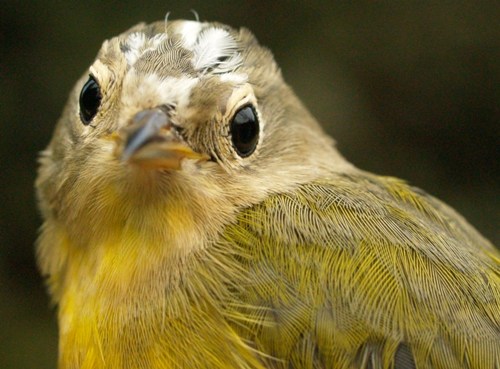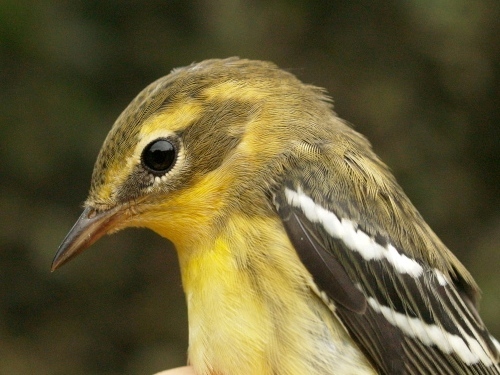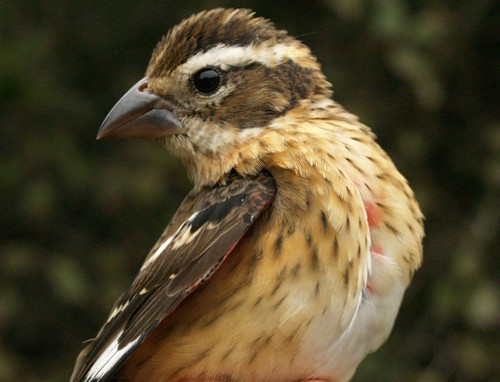|
Week 6: September 5 - 11, 2011 |
Welcome
to the McGill Bird Observatory weekly report.
Click here for a complete listing of our archives.
Comments or
questions are welcome at "mbo AT migrationresearch.org".
|
PICTURE
OF THE WEEK: |
|

Our record count of Cape May Warblers this fall continues to grow - the one above
was our 18th banded over the past six weeks, tripling our previous season high total.
(Photo by Simon Duval)
-
|
|
|
THIS WEEK |
THIS FALL |
2011 TOTAL |
SITE TOTAL |
|
# birds (and species) banded |
257 (37) |
1340 (56) |
2428 (74) |
33997 (108) |
|
# birds (and species) repeat |
45 (17) |
255 (30) |
410 (39) |
5917 (68) |
|
# birds (and species) return |
1 (1) |
14 (8) |
109 (20) |
916 (37) |
|
# species observed |
77 |
112 |
146 |
202 |
|
# net hours |
480.0 |
3035.1 |
5872.1 |
55489.2 |
|
# birds banded / 100 net hours |
53.5 |
44.2 |
41.3 |
61.2 |
|
|
Note: table does not include nocturnal banding (owls) |
|
Bander-in-charge: Simon Duval, Gay Gruner
Assistants: Mike Beaupré, Nicolas Bernier, Jean Demers, Leah Den Besten, Alison Hackney, Lima Kayello, Lisa Keelty, Francine Marcoux, Barbara MacDuff, Betsy McFarlane, Chris Murphy, Armin Nazemi, Joey O'Connor, Kevin Poirier, Catherine Russell, Clémence Soulard, Bonnie Soutar, Alex Stone, Patricia Stotland, Rodger Titman, Matthew von Bornhoft
Notes: After two consecutive weeks of record numbers for late August and early September, this week's banding total represents a more average count for this time of year. The week began with Monday being rained out, then two relatively busy days with 63 and 90 birds banded. However, afterwards migration quieted down, with between 14 and 41 birds banded daily for the rest of the week, despite operating full net hours. Our season total has now fallen behind where we were at this time last year, but is still greater than in any of our earlier years. With Eastern Phoebe as this week's only new species banded for the fall, our total of 58 species to date is now the lowest we've ever had by this point in the season.

Every once in a while we catch an individual with some white feathers in unusual places, including this Nashville Warbler with an unusually decorated crown.
(Photo by
Simon Duval) |
Just as the number of species banded to date this fall is lower than ever before, our count of species observed is also unusually low. The five additions this week were Osprey, Broad-winged Hawk, Northern Goshawk, Orange-crowned Warbler, and White-crowned Sparrow, bringing our total to 112. We also had our first Black-capped Chickadee return of the fall, one of our resident birds that had avoided us for a while
This week’s top 10 [last week's rank in brackets]
# individuals banded |
mean # individuals observed daily |
1. Magnolia Warbler (52) [1] |
1. Canada Goose (65) [1] |
2. Tennessee Warbler (37) [2] |
2. Broad-winged Hawk (44) [-] |
3. Nashville Warbler (21) [4] |
3. American Crow (33) [3] |
4. Wilson's Warbler (18) [5] |
4. Black-capped Chickadee (26) [4] |
5. Red-eyed Vireo (11) [-] |
5. American Goldfinch (20) [6] |
6. American Redstart (10) [3] |
6. Cedar Waxwing (17) [2] |
7. Indigo Bunting (9) [-] |
7. Magnolia Warbler (14) [5] |
7. White-throated Sparrow (9) [-] |
8. Tennessee Warbler (12) [7] |
9. Blackpoll Warbler (8) [-] |
9. Blue Jay (9) [-] |
10. Cedar Waxwing (7) [-]
10. Common Yellowthroat (7) [7]
|
10. Song Sparrow (8) [-] |
|
The most frequently banded species this week were an interesting mix, with the top four nearly matching last week's list, but with five new entries in the remainder of the top ten. Magnolia Warbler took the top spot for week 6, for the fourth time in the past six years, and the total of 181 banded so far this season puts the species far in front of all others. In second place for a second straight week, and moving into third for the season, is Tennessee Warbler, now up to a season total of 131, which beats last year's record of 114. American Redstart dropped from third place last week to sixth this week, but increased to a season total of 134, in striking distance of last year's record of 149. Nashville and Wilson's Warbler numbers were similar to week 5, and each moved up one spot in the table thanks to the drop by American Redstart. Red-eyed Vireo can be a bit erratic but is often common in week 6, with this marking the fifth year in a row that it is in the middle of the top ten list for this week. On the contrary, the 9 Indigo Buntings banded this week is a record for week 6. Rounding out the top ten were some early White-throated Sparrows, a slightly above-average count of Blackpoll Warblers, some more Common Yellowthroats, and enough Cedar Waxwings to set a new season record of 44 banded, with more likely yet to come.
Canada Goose remained the most abundant bird observed this week, mirroring the pattern from 2009, but quite different from most other years when the species was either in the mid to lower reaches of the top ten or not even on the list this early in fall. The big surprise this week was the dominant showing by Broad-winged Hawk, thanks primarily to a record-shattering estimate of 300 individuals kettling over the site on Saturday September 10. American Crow and Black-capped Chickadee remained in third and fourth place with numbers similar to last week, American Goldfinch moved up slightly to fifth place, and Cedar Waxwing dropped to sixth from second at a time of year when numbers are more typically increasing, but their abundance has been atypical throughout this fall. Magnolia and Tennessee Warblers remained unusually abundant this week, while Blue Jay and Song Sparrow squeaked in at the bottom of this week's list.
|

Although still comparatively scarce, with only 6 individuals banded this fall, Blackburnian Warbler is another of the several warbler species with above-average numbers this fall.
(Photo by
Simon Duval)

Unlike the warblers, Rose-breasted Grosbeak is among the species that has been unusually rare this fall. This was only our 14th individual of the season, compared to an average of over 30 by the end of week 6 in previous years. Given that numbers usually peak in early August, we will almost certainly have a record low total this fall.
(Photo by
Simon Duval)
|




